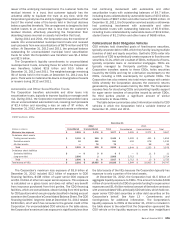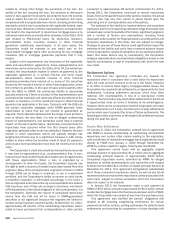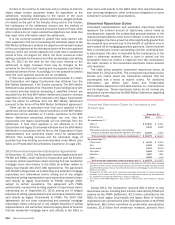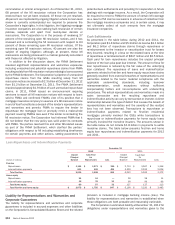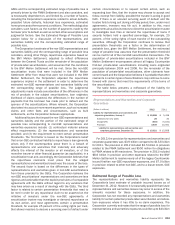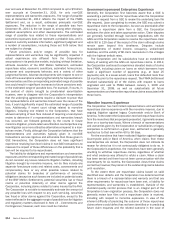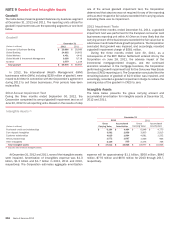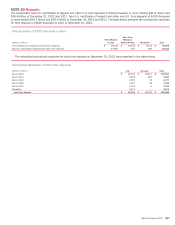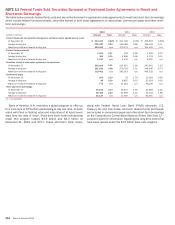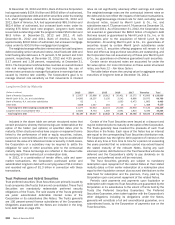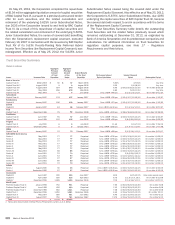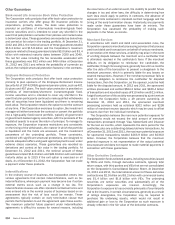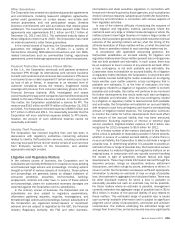Bank of America 2012 Annual Report Download - page 217
Download and view the complete annual report
Please find page 217 of the 2012 Bank of America annual report below. You can navigate through the pages in the report by either clicking on the pages listed below, or by using the keyword search tool below to find specific information within the annual report.Bank of America 2012 215
unasserted claims to repurchase loans from the securitization
trusts in which these monolines have insured all or some of the
related bonds, the Corporation cannot reasonably estimate the
eventual outcome through the repurchase process. As a result, a
liability for representations and warranties has not been
established related to repurchase claims where a valid defect has
not been identified, or in the case of any unasserted claims to
repurchase loans from the securitization trusts in which such
monolines have insured all or some of the related bonds. For
additional information related to the monolines, see Note 13 –
Commitments and Contingencies.
At December 31, 2012, for loans originated between 2004 and
2008, the unpaid principal balance of loans related to unresolved
monoline repurchase claims was $2.4 billion, substantially all of
which the Corporation has reviewed and declined to repurchase
based on an assessment of whether a material breach exists. As
noted above, a portion of the repurchase claims that are initially
denied are ultimately resolved through bulk settlement,
repurchase or make-whole payments, after additional dialogue and
negotiation with the monoline insurer. At December 31, 2012, the
unpaid principal balance of loans in these vintages for which the
monolines had requested loan files for review but for which no
repurchase claim had been received was $5.3 billion, excluding
loans that had been paid in full or resolved through settlements.
Of these file requests, $4.0 billion are aged and subject to ongoing
litigation. There will likely be additional requests for loan files in
the future leading to repurchase claims. Such claims may relate
to loans that are currently in securitization trusts or loans that
have defaulted and are no longer included in the unpaid principal
balance of the loans in the trusts. However, it is unlikely that a
repurchase claim will be received for every loan in a securitization
or every file requested or that a valid defect exists for every loan
repurchase claim. In addition, amounts paid on repurchase claims
from a monoline are paid to the securitization trust and are applied
in accordance with the terms of the governing securitization
documents which may include use by the securitization trust to
repay any outstanding monoline advances or reduce future
advances from the monolines. To the extent that a monoline has
not advanced funds or does not anticipate that it will be required
to advance funds to the securitization trust, the likelihood of
receiving a repurchase claim from a monoline may be reduced as
the monoline would receive limited or no benefit from the payment
of repurchase claims. Moreover, some monolines are not currently
performing their obligations under the financial guarantee policies
they issued which may, in certain circumstances, impact their
ability to present repurchase claims, although in those
circumstances, investors may be able to bring claims if contractual
thresholds are met.
Whole Loan Sales and Private-label Securitizations
Experience
The majority of the repurchase claims that the Corporation has
received and resolved outside of those from the GSEs and
monolines are from third-party whole-loan investors. The
Corporation provided representations and warranties and the
whole-loan investors may retain those rights even when the loans
were aggregated with other collateral into private-label
securitizations sponsored by the whole-loan investors. The
Corporation reviews properly presented repurchase claims for
these whole loans on a loan-by-loan basis. If, after the
Corporation’s review, it does not believe a claim is valid, it will deny
the claim and generally indicate a reason for the denial. When the
whole-loan investor agrees with the Corporation’s denial of the
claim, the whole-loan investor may rescind the claim. When there
is disagreement as to the resolution of the claim, meaningful
dialogue and negotiation between the parties are generally
necessary to reach a resolution on an individual claim. Generally,
a whole-loan investor is engaged in the repurchase process and
the Corporation and the whole-loan investor reach resolution,
either through loan-by-loan negotiation or at times, through a bulk
settlement. As of December 31, 2012, 15 percent of the whole-
loan claims that the Corporation initially denied have subsequently
been resolved through repurchase or make-whole payments and
44 percent have been resolved through rescission or repayment
in full by the borrower. Although the timeline for resolution varies,
once an actionable breach is identified on a given loan, settlement
is generally reached as to that loan within 60 to 90 days. When a
claim has been denied and the Corporation does not have
communication with the counterparty for six months, the
Corporation views these claims as inactive; however, they remain
in the outstanding claims balance until resolution.
In private-label securitizations, certain presentation thresholds
need to be met in order for investors to direct a trustee to assert
repurchase claims. Recent increases in new private-label claims
are primarily related to repurchase requests received from trustees
and third-party sponsors for private-label securitization
transactions not included in the BNY Mellon Settlement, including
claims related to first-lien third-party sponsored securitizations
that include monoline insurance. Over time, there has been an
increase in requests for loan files from certain private-label
securitization trustees, as well as requests for tolling agreements
to toll the applicable statutes of limitation relating to
representations and warranties repurchase claims, and the
Corporation believes it is likely that these requests will lead to an
increase in repurchase claims from private-label securitization
trustees with standing to bring such claims. The representations
and warranties, as governed by the private-label securitization
agreements, generally require that counterparties have the ability
to both assert a claim and actually prove that a loan has an
actionable defect under the applicable contracts. While the
Corporation believes the agreements for private-label
securitizations generally contain less rigorous representations and
warranties and place higher burdens on investors seeking
repurchases than the express provisions of comparable
agreements with the GSEs, without regard to any variations that
may have arisen as a result of dealings with the GSEs, the
agreements generally include a representation that underwriting
practices were prudent and customary. In the case of private-label
securitization trustees and third-party sponsors, there is currently
no established process in place for the parties to reach a
conclusion on an individual loan if there is a disagreement on the
resolution of the claim. For additional information on repurchase
demands, see Unresolved Repurchase Claims on page 210.
At December 31, 2012, for loans originated between 2004 and
2008, the notional amount of unresolved repurchase claims
submitted by private-label securitization trustees and whole-loan
investors was $12.2 billion. The Corporation has performed an
initial review with respect to $10.9 billion of these claims and does
not believe a valid basis for repurchase has been established by
the claimant and is still in the process of reviewing the remaining
$1.3 billion of these claims.


